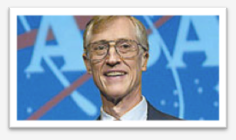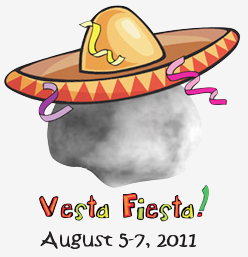This is anexclusive invitation just for participating NASA Explorer Schools high schoolteachers.

Are your students boggled by the big bang theory? Are they captivated by cosmic background radiation? Are they fascinated by the formation of planets, stars and galaxies? Then May’s NES online video chat is their chance to have their questions answered. Dr. John C. Mather, Senior Project Scientist for the James Webb Space Telescope and 2006 Nobel Prize winner in physics for his work on the big bang theory, will be answering student questions during a live video chat.
Thehour-long chat will be on Tuesday, May 17, beginning at 1:30 p.m. EDT.
Teachersare invited to send up to 10 student questions to Mather through either digitalvideo or email. Video questions will be given priority.
Submitting a Question (The deadlinefor submitting questions is May 1):
Allquestions must include:
- The student’s FIRST NAME only
- Grade/subject
- School name
- The question
For example, “My name is Sara and I’m a 10th-grade astronomystudent at Johnson High School. My question is…”
Video questions:
- Request a blank media release form from nasa-explorer-schools@mail.nasa.gov. A completed NES media release form must be submitted for each student featured in a video. Media release forms must be faxed to 216-433-5924 or scanned and sent to nasa-explorer-schools@mail.nasa.gov with the subject “Media Release for Dr. Mather Chat.”
- One student question per file and 10 questions per teacher may be submitted.
- To improve the chances of your video being selected, review the “Camera Techniques” list at the bottom of this message.
- All submitted video files will be destroyed at the conclusion of the video chat. Questions asked during the chat will be part of the video archive, which will be available on the NES Virtual Campus website.
Email questions: Student questions may be sent bythe teacher to nasa-explorer-schools@mail.nasa.gov, with the subject, “Dr.Mather Chat.” Teachers may submit up to 10 student questions as text in thebody of a single email and only one email per teacher can be accepted.
Onlyquestions following these guidelines will be considered. Selected questionswill be included in the May 17 chat with Dr. Mather.
Watchthe video chat at on the Virtual Campus.
Camera Techniques for StudentQuestions:
- Be sure your camera is set to the highest quality video settings.
- Position the camera on a tripod at eye level with the student.
- Only the student asking the question should be seen in the video.
- Record in a well-lit area, with no bright lights or windows visible in the picture behind the student.
- The student should be at least six feet from a wall or background.
- The student should be no more than four feet from the camera.
- Frame the student from waist up or mid-chest up.
- Record in an area free from loud noises or HVAC units.
- If possible, for best audio quality, use an external hand-held or lavaliere microphone.
- When recording, make sure the student speaks clearly in a full voice and doesn’t rush through the question.
- Contact nasa-explorer-schools@mail.nasa.gov for uploading instructions.
Link to the NES Virtual Campus home page.
 Celebrate the beginning of Dawn’s year-long exploration of new worlds. After close to four years cruising at stunning speeds, the robotic spacecraft is catching up to its first destination in the main asteroid belt: Vesta. Don’t Dawn and Vesta deserve a fiesta?
Celebrate the beginning of Dawn’s year-long exploration of new worlds. After close to four years cruising at stunning speeds, the robotic spacecraft is catching up to its first destination in the main asteroid belt: Vesta. Don’t Dawn and Vesta deserve a fiesta?
.jpg) NASA Explorer Schools educator Cheryl May at Lebanon Middle School challenged her 7th-grade science and technology students by adding her own extensions to the Sun-Earth-Moon Model activity. In the activity, students create a model of the Earth, sun and moon system. Students observe the moon’s orbit of Earth simultaneously with Earth’s orbit of the sun. This is an effective way to model eclipses and the position of Earth, the moon and the sun during the moon’s phases.
NASA Explorer Schools educator Cheryl May at Lebanon Middle School challenged her 7th-grade science and technology students by adding her own extensions to the Sun-Earth-Moon Model activity. In the activity, students create a model of the Earth, sun and moon system. Students observe the moon’s orbit of Earth simultaneously with Earth’s orbit of the sun. This is an effective way to model eclipses and the position of Earth, the moon and the sun during the moon’s phases. NASA Explorer Schools educator Elizabeth Petry from Mack Benn Jr. Elementary School used NES resources to encourage her students to read and write. Students began their adventure by participating in a videoconference activity in which they explored the solar system. Afterward, students conducted research and prepared a fact to share about their planet as part of a Reader’s Theater activity. Petry showed the NASA Now program, “Reasons for the Seasons,” and arranged for students to participate in a NASA Digital Learning Network videoconference, Our Solar Neighborhood.
NASA Explorer Schools educator Elizabeth Petry from Mack Benn Jr. Elementary School used NES resources to encourage her students to read and write. Students began their adventure by participating in a videoconference activity in which they explored the solar system. Afterward, students conducted research and prepared a fact to share about their planet as part of a Reader’s Theater activity. Petry showed the NASA Now program, “Reasons for the Seasons,” and arranged for students to participate in a NASA Digital Learning Network videoconference, Our Solar Neighborhood.
 NASA Explorer Schools invites K-12 students across the United States to chat with NASA civil engineer Sam Ortega, Program Manager of Centennial Challenge. Ortega will answer questions about building and testing solid fuel rocket motors and being a civil engineer at NASA during a live video webchat tomorrow, Tuesday April 19, 2011 at 2 p.m. EDT.
NASA Explorer Schools invites K-12 students across the United States to chat with NASA civil engineer Sam Ortega, Program Manager of Centennial Challenge. Ortega will answer questions about building and testing solid fuel rocket motors and being a civil engineer at NASA during a live video webchat tomorrow, Tuesday April 19, 2011 at 2 p.m. EDT. The MESSENGER mission to Mercury uses infrared light to study properties of the planet. However, too much infrared radiation is detrimental to the spacecraft and its instruments.
The MESSENGER mission to Mercury uses infrared light to study properties of the planet. However, too much infrared radiation is detrimental to the spacecraft and its instruments. As we look forward to the final launch of Endeavour, George Hatcher joins us to explain what it’s like to sit at the console in the launch control center during countdown. Learn about the tremendous amount of teamwork required between the Flight Control, Guidance and Navigation engineers and the entire team in the firing room to ensure a safe launch.
As we look forward to the final launch of Endeavour, George Hatcher joins us to explain what it’s like to sit at the console in the launch control center during countdown. Learn about the tremendous amount of teamwork required between the Flight Control, Guidance and Navigation engineers and the entire team in the firing room to ensure a safe launch. NASA Explorer Schools, in cooperation with Oklahoma State University, is pleased to announce the opportunity for registered NES educators to earn Continuing Education Units for participation in live NES electronic professional development sessions! Educators who fully participate in seven live e-PDs and complete the evaluation survey on the Virtual Campus for each live e-PD will earn one CEU. Those completing fourteen live e-PDs and surveys will earn two CEUs.
NASA Explorer Schools, in cooperation with Oklahoma State University, is pleased to announce the opportunity for registered NES educators to earn Continuing Education Units for participation in live NES electronic professional development sessions! Educators who fully participate in seven live e-PDs and complete the evaluation survey on the Virtual Campus for each live e-PD will earn one CEU. Those completing fourteen live e-PDs and surveys will earn two CEUs. Small samples of representative lunar rocks and soils, embedded in rugged acrylic disks suitable for classroom use, are available for short-term loan to qualified school teachers. Each teacher must become a certified user of the disks through a brief training program prior to receiving a disk. Educational sample disks are distributed on a regional basis from NASA field centers located across the United States. For further details, use the contact information below.
Small samples of representative lunar rocks and soils, embedded in rugged acrylic disks suitable for classroom use, are available for short-term loan to qualified school teachers. Each teacher must become a certified user of the disks through a brief training program prior to receiving a disk. Educational sample disks are distributed on a regional basis from NASA field centers located across the United States. For further details, use the contact information below. In this episode of NASA Now, you’ll meet aerospace engineer Aisha Bowe, who is helping NASA solve this complex problem. Learn why there is no perfectly designed system and all technological solutions have trade-offs, such as safety, cost or efficiency. Learn about the types of conflicts aircraft encounter and how engineers use trade-offs to come up with the best overall solution.
In this episode of NASA Now, you’ll meet aerospace engineer Aisha Bowe, who is helping NASA solve this complex problem. Learn why there is no perfectly designed system and all technological solutions have trade-offs, such as safety, cost or efficiency. Learn about the types of conflicts aircraft encounter and how engineers use trade-offs to come up with the best overall solution.